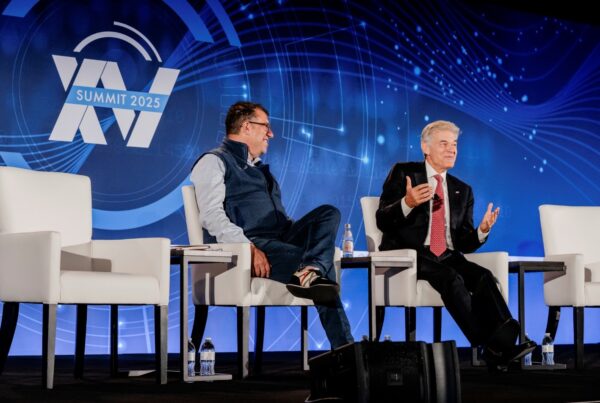Earlier this week, Northwell Health announced that 1,400 of its employees—less than two percent of its workforce—were fired because of a refusal to get vaccinated. While 2 percent isn’t a huge number for a system that employs nearly 80,000 people, it’s certainly going to have an impact on staffing availability in the near term.
This move is emblematic of the tough decisions being made across the health care industry as leaders grapple with staff and patient safety concerns while facing an uphill climb on labor. Federal and state mandates have largely made it a matter of when, not if, health care CEOs will have to make moves to ensure their workforce is 100 percent vaccinated. For some, it wasn’t a hard decision to make.
“It was never a question of if we would mandate, it was a question of when we would mandate,” said Marc Boom, CEO of Houston Methodist, the first hospital in the U.S. to mandate the vaccine for its employees. “We see it as our culture and responsibility to keep patients safe.”
Other CEOs are having a tougher time with the idea of enforcing a vaccine mandate. In particular, rural health care and safety-net CEOs and those who run home health agencies say mandates put them in a difficult position thanks to a scarcity of labor availability. Alan Levine, CEO of Ballad Health, a health system with hospitals in rural Virginia and Tennessee, says he thinks a mandate will help to solve the problem of unvaccinated Americans while also one problem while creating another problem.
“The reason we haven’t mandated it is we are a fairly large health system in a rural region of the country where even before COVID there was a terrible nursing shortage. It’s not just in nursing, but it’s most acute in nursing. The pandemic has made it much worse, and it’s put a lot of pressure on us because of the increased volumes we’ve seen. In the middle of this, putting a mandate on our people where we could lose 5-10 percent of our workforce, can exacerbate our shortage. It could hurt people who have COVID and people who don’t have it and delay their access to care because we won’t have enough staff,” says Levine.
Read more: Early lessons from CEOs who required vaccines before Biden’s mandate
Rural health challenges
The data suggests there is veracity behind Levine’s concerns. One report states that the country will face a shortage of 122,000 physicians by 2032 and will need to hire at least 200,000 nurses per year to meet increased demand. In rural areas, according to a Health Resources and Services Administration (HRSA) report, rural regions make up the majority of areas impacted by these shortages. More than half of the people in rural areas face a shortage of health professionals within their region.
“Mandates threaten the access to care in a rural context. I’m hearing from rural hospitals out there that have as high as 40 percent of their hospital staff unvaccinated. Will all those people quit? Absolutely not. But in a rural context, I’m concerned about even 2-to-5 percent of those people walking away. That will create some real pressure on these hospitals,” says Alan Morgan, CEO of the National Rural Health Association.
At Ballad Health, which has a 63 percent vaccination rate, Levine says that the COVID-19 pandemic has meant that frontline clinicians have been constantly hit with surges and packed ICUs. These waves created a sense of instability and stress, which eventually led to many employees getting burned out and quitting. He’s worried that a lot of experienced bedside nurses are going to walk away from the profession. Levine says state and federal government officials need to recognize that regional differences exist when it comes to vaccine mandates.
“I’m not a believer in broad, sweeping mandates because every corner of the country is different. We’re in a rural area where if we lose a little bit of our staff because of the mandate, it puts us in a real bad position. I understand why the President did it and I agree with the reason…but I don’t think it’s the best policy. You can’t make decisions like this in a vacuum,” Levine says.
Levine says that rural regions in general tend to have more of a distrust of the health care system, which plays into vaccine rates being lower in those areas. He also says it hasn’t helped that there hasn’t a lot of clarity on COVID-19 from both the Biden and Trump administrations since the start of the pandemic. He points specifically to how the FDA’s guidance on booster shots differed from what the Biden administration is recommending as an example of why people don’t believe what health institutions tell them.
“I was the health secretary in two states during natural disasters. I was the health secretary in Florida during 10 major hurricanes that made landfall and I was the secretary in Louisiana during Hurricanes Gustav and Ike as well as the last pandemic. The lesson I learned early was if you don’t know the answer to something, say you don’t know. Just give people facts that are verifiable,” Levine says.
In terms of alternative methods of increasing vaccination rates, Levine says he prefers a combination of educating the unvaccinated on the benefits of getting the shot and adding surcharges to their premiums, since Ballad is a self-insured employer. As people leave the workforce over an unwillingness to be vaccinated, Morgan at the National Rural Health Association is concerned that hospitals will have to start diverting care, which has already happened at some places.
Read more: The behavioral economics of COVID-19 vaccines
He says that hospitals in rural regions don’t have a lot of resources to manage these problems and would expect state and federal government to deploy FEMA, National Guard, public health service workers and other emergency personnel to respond to these challenges. Longer term, he’d like to see HRSA deploy more resources to incentivize health care workers to get jobs in rural communities. “There has to be more money put into rural residency programs,” says Morgan. “At the federal level, we need money supporting these programs.”
We can’t lose the sight of the fact 95 percent of the people did get vaccinated, are here and are working. We want to support them as much as we can for the great work they’re doing to save lives.
Tom Quatroche Jr., PhD, , CEO of Erie County Medical Center
Home health agency and nursing homes
There’s no question that most—if not all—CEOs in health care want to see their employees get vaccinated. Where they differ is how to get it done and how fast they should be forcing these mandates on people. Tom Quatroche Jr., PhD, CEO of Erie County Medical Center, which covers the eight counties surrounding the Buffalo metropolitan area, isn’t opposed to the idea of a mandate. His problem with the New York state mandate as well as the federal mandate is that they didn’t give organizations like his enough time to strategize around staffing shortages.
“We needed more time to ramp up hiring and look at other ways we can increase our staffing levels,” says Quatroche Jr. “I understand the desire to get the mandate done, but we needed a little more time to adjust.”
The problem is particularly troublesome with Erie County Medical Center’s nursing home unit, Quatroche Jr. says. While overall 95 percent of Erie County Medical’s employees are vaccinated, the number is at 85 percent in nursing homes. If people do not get vaccinated by November 1, they will no longer be employed by the organization, he says.
“We are short staffed, especially in the nursing home. The nursing home issue is a more acute challenge than the hospitals because they were already short staffed. Because of the reimbursement model in nursing homes, there are a lot of clinical aides, and those aides have a lot of options to work outside of health care and make the same kind of money,” Quatroche Jr. says.
Indeed, nursing homes and home health agencies are having the toughest time of any health care profession in getting employees vaccinated. A recent study in JAMA found that clinical nursing assistants (CNAs) were the lowest vaccinated in nursing home settings at less than 50 percent on average. A study from Kaiser Family Foundation found that only 26 percent of home health aides have received a vaccine as of April—far below any other health care profession.
Kevin Smith, CEO of Best of Care, a Massachusetts-based home health agency, says that the industry has been dealing with workforce shortage issues long before COVID came around. The pandemic laid the issue bare and the demand for home health services has never been higher because of this shortage.
“We are competing against retail, big box, publicly-traded, billionaire-owned companies. How do you compete against Amazon when they’ll give people the same hourly pay that we give them, but also a large sign-on bonus and tell them they’ll work in the same place every day on a dedicated shift, whereas our aides are driving around?” Smith says. “There is a lot of volatility with a home-care worker schedule. You see rising wage floors in other industries where you don’t need a lot of skills and it’s an easy decision for employees.”
Best of Care is around 60 percent vaccinated, Smith says, and he’s made concerted efforts to try and increase those numbers with education modules, paid time off, and partnership with clinics. But Smith knows they are dealing with a ticking clock. Short of those who get a medical or religious exemption, the reality is they are going to lose a lot of people by November 1st when the Biden mandate goes into effect, he says.
“I’d like to think we were as accommodating and encouraging as possible. We’ve hit a plateau. Anyone who was going to get the vaccine has got it. Access is no longer an issue. We have seen some people get the vaccine as part of the mandate, but there’s a lot of people not accounted for,” Smith says.
Read more: Increasing Vaccine Uptake in Diverse Communities
The trust factor
People in these home health roles are often immigrants and people of color, who have a distrust of government-issued mandates, says Helen Adeosun, CEO of Care Academy, which provides online education to direct care workers. She says that health care leaders need to understand these concerns, address them, and find people they can trust to advocate for the vaccine.
“It’s going to be beating the drum of education, community and support from other caregivers,” Adeosun says. “There is no one-shot deal. It’s a multipronged effort. I know we can’t afford time…but it is time that will get it done. I realize we have a short fuse in terms of being in a pandemic, but between now and the next pandemic, we have to build equity that allows for trust in the health care system.”
Lack of trust in the health care system is a prevalent problem in underserved communities where vaccine rates may lag the national and statewide rates. To gain employee trust, Quatroche Jr. says Erie County Medical Center brought in leaders from the pastoral community to try and improve vaccine rates within its own workforce. At the end of the day, he notes, if people are willing to lose their jobs over getting a vaccine, he doesn’t think there’s much an organization can do to convince them to get the shot. Instead, he’s focused on building the workforce with those who can fill the vacancies.
“We are in full-on recruitment mode to add staff. We’re hiring more recruiters and bypassing some of our typical processes. We’re really trying to streamline the process. We have about 500 positions open and employ 3,500 people,” Quatroche Jr. says. He works with other health care CEOs in the state as a way to collectively advocate for more help in these hiring efforts. He also focuses on the people who have gotten vaccinated, which he says shouldn’t get lost in the efforts to persuade the unvaccinated.
“We spend a lot of time talking internally, and with my fellow [peer CEOs], about supporting the individuals who are here. We can’t lose the sight of the fact 95 percent of the people did get vaccinated, are here and are working. We want to support them as much as we can for the great work they’re doing to save lives,” he said.












